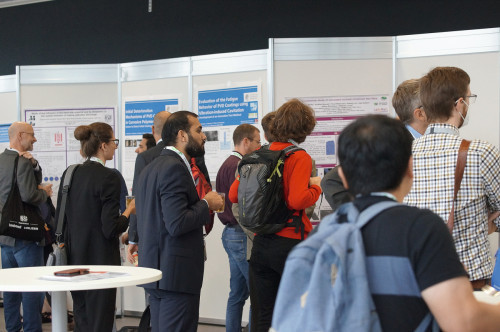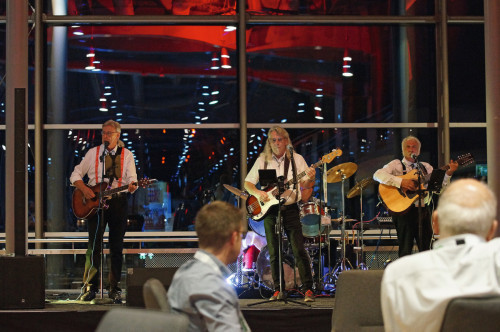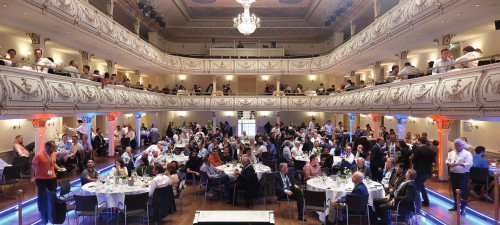The 18th International Conference on Plasma Surface Engineering PSE 2022 took place from September 12 to 15, 2022 in Erfurt, Germany. It was organized by the European Joint Committee on Plasma and Ion Surface Engineering (EJC/PISE), the European Research Association Thin Films e.V. and Plasma Germany.
Around 500 participants from industry, research and institutions met in Erfurt. The historic city, which Goethe had already appreciated and often visited, provided a worthy setting. The main focus of the conference was the session program with accompanying poster presentations. The PSE Awards were presented in this context. Three tutorials rounded off the program. Visitors used the industry exhibition with an industry evening on the second day of the conference to exchange information and experiences and to make and maintain contacts. At the conference dinner, the 30th anniversary of the European Research Society for Thin Films (EFDS) and its activities were honoured - an institution that has successfully hosted the PSE and organized workshops and other events in recent years. Another area of activity is the initiation of projects and cooperations, with which the EFDS contributes to the success of Germany as a business location.
The opening
Conference Chairman Prof. Jaroslav Vlcek, University of West Bohemia, Czech Republic, welcomed the participants and the organizer of the event, Prof. Udo Klotzbach, Europäische Forschungsgesellschaft Dünne Schichten e.V., Germany. The partner country of this year's PSE was the Czech Republic, which has been active in plasma and ion surface technology for many years and was represented by numerous representatives from research and industry.
The topics
 The industrial exhibition and the breaks offered the opportunity to exchange information and experiences
The industrial exhibition and the breaks offered the opportunity to exchange information and experiences
The main theme of this year's conference was "Changes in Plasma Surface Engineering" - both industrially established and new approaches were presented. For example, the demand to reduce the ecological footprint (CO2) has initiated various development directions, such as the development of electrolysers and fuel cells for hydrogen technology or batteries with higher storage capacity. The production of hydrocarbons using plasma conversion processes or the material and/or design-optimized production of components using additive manufacturing were presented as interesting topics for the future. Processes for the production of "green" hydrogen were also presented. The necessary corrosion resistance of the materials used and the reduction of the interfacial energy can only be guaranteed in these processes through the use of specific coatings.
The following topics were discussed in detail:
- Plasma and ion surface engineering
- Surface modification technologies
- Coating applications and properties
- Characterization and simulation of films and processes
- Changes in Plasma Surfaces Engineering (Main Topic)
- Plasma(-catalysis) in gas conversion processes (Trend Topic)
Selected presentations with a focus on surface technology are briefly presented below. Those interested in further information are requested to contact the EFDS or the speakers directly.
The presentations
In her presentation "The Hydrogen Economy: Perspectives for Vacuum Technologies", Dr. Lucia Mendizibal, Tekniker, Spain, presented coatings for infrastructure components for the production, storage and transport of "green" hydrogen. These are necessary because the mechanical properties of the base materials (e.g. stainless steel) can be altered in contact with liquid or gaseous hydrogen. Ms. Mendizibal spoke about various protective coatings based on nickel, carbon, titanium and tantalum that can be applied using vacuum processes. Increasingly interesting are also catalytically effective coatings with embedded nanoparticles, which can be applied in a roll-to-roll process.
"Vacuum Coating in All-Solid-State Battery Manufacturing-Applications, Prospects and Challenges". In his presentation, Dr. Markus Piwko, Von Ardenne, showed that vacuum coatings enable optimization in practically all components of solid-state batteries. This applies to the cell components (Al current collector, cathode and catholyte, separator, anode and anolyte, Cu current collector) as well as the interfaces between the individual components. The process and plant technology required for this is fully developed. The speaker gave examples of the use of magnetron sputtering and electron beam evaporation to optimize the various components and interfaces of solid-state batteries.
In the presentation "Decorative and Advance Coating for Automotive Application", Chinmay Trivedi, Hauzer Techno Coatings, Venlo, presented the Cromatipic technology, an environmentally friendly process for metallizing (chrome plating) plastics. The plastic surface is first coated with a UV lacquer, which is then activated in a plasma and finally a chrome layer is applied by UBM sputtering or PACVD. Hauzer Iberica carries out this process on an industrial scale.
"Plasmas and Polymers: From 0- to 3D Nanomaterials". After a historical overview of the beginnings of polymer and plasma technology, Prof. Andrei Choukourov, Charles University, Prague, spoke about thin films that can be synthesized by plasma polymerization and the processes for their production and deposition. PECVD or sputtering processes are used for plasma polymerization at low pressure, while plasma jets or dielectric barrier discharge (DBD) are used at atmospheric pressure. The evaporation of polymers, sputtering of polymer targets or plasma polymerization in solutions are also possible. The properties of the deposited films can be specifically adjusted using suitable gaseous or liquid precursors and the process parameters. Nanostructured or nanoparticle-containing films can also be synthesized. Various applications such as the administration of drugs (drug release) or the synthesis of alkanes without metal catalysts rounded off the presentation. The lecture was held as part of the meeting of the partner country Czech Republic.
The industrial exhibition
The industrial exhibition with 62 exhibitors was able to present their processes, products and services to a wide audience in the spacious halls of Messe Erfurt. On one day, visitors who were not attending the conference were able to visit it free of charge. Thuringia's Minister of Economics and Science, Wolfgang Tiefensee, also attended and personally addressed the conference participants.
The industry workshop
With a focus on "Changes in Plasma Surface Engineering", the industry workshop presented new ways of reducingCO2 emissions through the use of additive manufacturing and the development of new materials. For example, solid-state batteries without liquid electrolytes can achieve higher power densities than conventional batteries. The risk of fire is also minimized compared to lithium-based liquid electrolyte batteries. Various PVD processes were presented and evaluated for the production of solid-state batteries.
Dates
Looking ahead to the 19th International Conference and Exhibition on Plasma Surface Engineering is announced for September 2-5, 2024.




